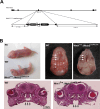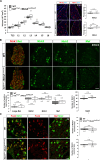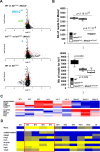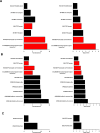Touch receptor end-organ innervation and function require sensory neuron expression of the transcription factor Meis2
- PMID: 38386003
- PMCID: PMC10942617
- DOI: 10.7554/eLife.89287
Touch receptor end-organ innervation and function require sensory neuron expression of the transcription factor Meis2
Abstract
Touch sensation is primarily encoded by mechanoreceptors, called low-threshold mechanoreceptors (LTMRs), with their cell bodies in the dorsal root ganglia. Because of their great diversity in terms of molecular signature, terminal endings morphology, and electrophysiological properties, mirroring the complexity of tactile experience, LTMRs are a model of choice to study the molecular cues differentially controlling neuronal diversification. While the transcriptional codes that define different LTMR subtypes have been extensively studied, the molecular players that participate in their late maturation and in particular in the striking diversity of their end-organ morphological specialization are largely unknown. Here we identified the TALE homeodomain transcription factor Meis2 as a key regulator of LTMRs target-field innervation in mice. Meis2 is specifically expressed in cutaneous LTMRs, and its expression depends on target-derived signals. While LTMRs lacking Meis2 survived and are normally specified, their end-organ innervations, electrophysiological properties, and transcriptome are differentially and markedly affected, resulting in impaired sensory-evoked behavioral responses. These data establish Meis2 as a major transcriptional regulator controlling the orderly formation of sensory neurons innervating peripheral end organs required for light touch.
Keywords: Meis2; TALE homeodomain; chicken; developmental biology; dorsal root ganglion; mouse; neuroscience; sensory neurons; transcription factor.
© 2023, Desiderio, Schwaller et al.
Conflict of interest statement
SD, FS, KT, KP, GL, PC, FM No competing interests declared
Figures















Update of
- doi: 10.1101/2022.04.28.489889
- doi: 10.7554/eLife.89287.1
- doi: 10.7554/eLife.89287.2
Similar articles
-
CaMKII Controls Whether Touch Is Painful.J Neurosci. 2015 Oct 21;35(42):14086-102. doi: 10.1523/JNEUROSCI.1969-15.2015. J Neurosci. 2015. PMID: 26490852 Free PMC article.
-
The specification and wiring of mammalian cutaneous low-threshold mechanoreceptors.Wiley Interdiscip Rev Dev Biol. 2016 May-Jun;5(3):389-404. doi: 10.1002/wdev.229. Epub 2016 Mar 17. Wiley Interdiscip Rev Dev Biol. 2016. PMID: 26992078 Free PMC article. Review.
-
Tiling and somatotopic alignment of mammalian low-threshold mechanoreceptors.Proc Natl Acad Sci U S A. 2019 May 7;116(19):9168-9177. doi: 10.1073/pnas.1901378116. Epub 2019 Apr 17. Proc Natl Acad Sci U S A. 2019. PMID: 30996124 Free PMC article.
-
The sensory neurons of touch.Neuron. 2013 Aug 21;79(4):618-39. doi: 10.1016/j.neuron.2013.07.051. Neuron. 2013. PMID: 23972592 Free PMC article. Review.
-
Cortical responses to touch reflect subcortical integration of LTMR signals.Nature. 2021 Dec;600(7890):680-685. doi: 10.1038/s41586-021-04094-x. Epub 2021 Nov 17. Nature. 2021. PMID: 34789880 Free PMC article.
Cited by
-
Pro-cognitive restoration of experience-dependent parvalbumin inhibitory neuron plasticity in neurodevelopmental disorders.Res Sq [Preprint]. 2025 Jan 16:rs.3.rs-5624085. doi: 10.21203/rs.3.rs-5624085/v1. Res Sq. 2025. PMID: 39877097 Free PMC article. Preprint.
-
The autism-associated Meis2 gene is necessary for cardiac baroreflex regulation in mice.Sci Rep. 2022 Nov 23;12(1):20150. doi: 10.1038/s41598-022-24616-5. Sci Rep. 2022. PMID: 36418415 Free PMC article.
-
Contributions and future potential of animal models for geroscience research on sensory systems.Geroscience. 2025 Feb;47(1):61-83. doi: 10.1007/s11357-024-01327-5. Epub 2024 Sep 23. Geroscience. 2025. PMID: 39312151 Free PMC article. Review.
-
Cleft palate, congenital heart disease, and developmental delay involving MEIS2 heterozygous mutations found in the patient with attention deficit hyperactivity disorder: a case report.Front Pediatr. 2024 Dec 24;12:1500152. doi: 10.3389/fped.2024.1500152. eCollection 2024. Front Pediatr. 2024. PMID: 39776641 Free PMC article.
References
-
- Abdollahi MR, Morrison E, Sirey T, Molnar Z, Hayward BE, Carr IM, Springell K, Woods CG, Ahmed M, Hattingh L, Corry P, Pilz DT, Stoodley N, Crow Y, Taylor GR, Bonthron DT, Sheridan E. Mutation of the Variant α-Tubulin TUBA8 results in polymicrogyria with optic nerve hypoplasia. The American Journal of Human Genetics. 2009;85:737–744. doi: 10.1016/j.ajhg.2009.10.007. - DOI - PMC - PubMed
MeSH terms
Substances
Associated data
- Actions
LinkOut - more resources
Full Text Sources
Molecular Biology Databases

